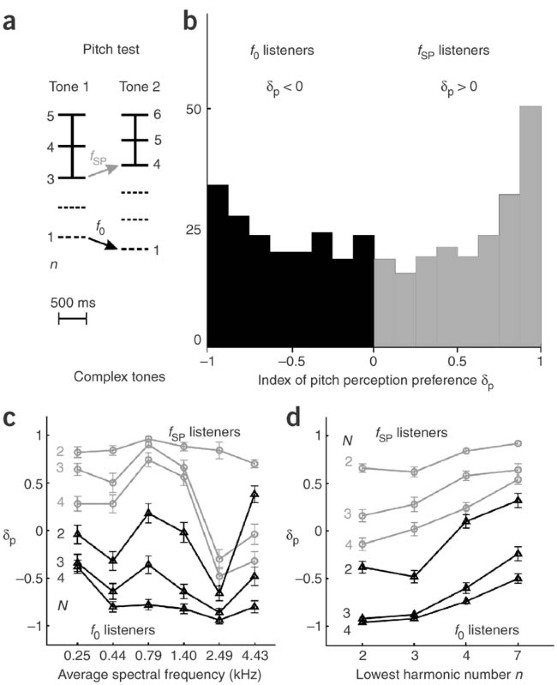
- Select a language for the TTS:
- UK English Female
- UK English Male
- US English Female
- US English Male
- Australian Female
- Australian Male
- Language selected: (auto detect) - EN
Play all audios:
ABSTRACT The relative pitch of harmonic complex sounds, such as instrumental sounds, may be perceived by decoding either the fundamental pitch (_f_0) or the spectral pitch (_f_SP) of the
stimuli. We classified a large cohort of 420 subjects including symphony orchestra musicians to be either _f_0 or _f_SP listeners, depending on the dominant perceptual mode. In a subgroup of
87 subjects, MRI (magnetic resonance imaging) and magnetoencephalography studies demonstrated a strong neural basis for both types of pitch perception irrespective of musical aptitude.
Compared with _f_0 listeners, _f_SP listeners possessed a pronounced rightward, rather than leftward, asymmetry of gray matter volume and P50m activity within the pitch-sensitive lateral
Heschl's gyrus. Our data link relative hemispheric lateralization with perceptual stimulus properties, whereas the absolute size of the Heschl's gyrus depends on musical aptitude.
Access through your institution Buy or subscribe This is a preview of subscription content, access via your institution ACCESS OPTIONS Access through your institution Subscribe to this
journal Receive 12 print issues and online access $209.00 per year only $17.42 per issue Learn more Buy this article * Purchase on SpringerLink * Instant access to full article PDF Buy now
Prices may be subject to local taxes which are calculated during checkout ADDITIONAL ACCESS OPTIONS: * Log in * Learn about institutional subscriptions * Read our FAQs * Contact customer
support SIMILAR CONTENT BEING VIEWED BY OTHERS METER ENHANCES THE SUBCORTICAL PROCESSING OF SPEECH SOUNDS AT A STRONG BEAT Article Open access 29 September 2020 AUDIOVISUAL STRUCTURAL
CONNECTIVITY IN MUSICIANS AND NON-MUSICIANS: A CORTICAL THICKNESS AND DIFFUSION TENSOR IMAGING STUDY Article Open access 22 February 2021 INDIVIDUAL DIFFERENCES IN HUMAN FREQUENCY-FOLLOWING
RESPONSE PREDICT PITCH LABELING ABILITY Article Open access 12 July 2021 REFERENCES * Smoorenburg, G.F. Pitch perception of two-frequency stimuli. _J. Acoust. Soc. Am._ 48, 924–942 (1970).
Article CAS Google Scholar * Laguitton, V., Demany, L., Semal, C. & Liégeois-Chauvel, C. Pitch perception: a difference between right-and left-handed listeners. _Neuropsychologia_ 36,
201–207 (1998). Article CAS Google Scholar * von Helmholtz, H.L.F. _On the Sensations of Tone_ (Longmans, London, 1885). Google Scholar * Terhardt, E. Pitch, consonance and harmony. _J.
Acoust. Soc. Am._ 55, 1061–1069 (1974). Article CAS Google Scholar * Wessinger, C.M. et al. Hierarchical organization of the human auditory cortex revealed by functional magnetic
resonance imaging. _J. Cogn. Neurosci._ 13, 1–7 (2001). Article CAS Google Scholar * Langner, G. Periodicity coding in the auditory system. _Hear. Res._ 60, 115–142 (1992). Article CAS
Google Scholar * Griffiths, T.D., Büchel, C., Frackowiak, R.S.J. & Patterson, R.D. Analysis of temporal structure in sound by the human brain. _Nat. Neurosci._ 1, 422–427 (1998).
Article CAS Google Scholar * Gutschalk, A., Patterson, R.D., Rupp, A., Uppenkamp, S. & Scherg, M. Sustained magnetic fields reveal separate sites for sound level and temporal
regularity in human auditory cortex. _Neuroimage_ 15, 207–216 (2002). Article Google Scholar * Formisano, E. et al. Mirror-symmetric tonotopic maps in human primary auditory cortex.
_Neuron_ 40, 859–869 (2003). Article CAS Google Scholar * Pantev, C., Hoke, M., Lütkenhöner, B. & Lehnerz, K. Tonotopic organization of the auditory cortex: pitch versus frequency
representation. _Science_ 246, 486–488 (1989). Article CAS Google Scholar * Seifritz, E. et al. Spatiotemporal pattern of neural processing in the human auditory cortex. _Science_ 297,
1706–1708 (2002). Article CAS Google Scholar * Griffiths, T.D. Functional imaging of pitch analysis. _Ann. NY Acad. Sci._ 999, 40–49 (2003). Article Google Scholar * Janata, P. et al.
The cortical topography of tonal structures underlying western music. _Science_ 298, 2167–2170 (2002). Article CAS Google Scholar * Hall, D. et al. Spectral and temporal processing in
human auditory cortex. _Cereb. Cortex_ 12, 140–149 (2002). Article Google Scholar * Penagos, H., Melcher, J.R. & Oxenham, A.J. A neural representation of pitch salience in nonprimary
human auditory cortex revealed with functional magnetic resonance imaging. _J. Neurosci._ 24, 6810–6815 (2004). Article CAS Google Scholar * Patterson, R.D., Uppenkamp, S., Johnsrude,
I.S. & Griffiths, T.D. The processing of temporal pitch and melody information in auditory cortex. _Neuron_ 36, 767–776 (2002). Article CAS Google Scholar * Warren, J.D., Uppenkamp,
S., Patterson, R. & Griffiths, T.D. Separating pitch chroma and pitch height in the human brain. _Proc. Natl. Acad. Sci. USA_ 100, 10038–10042 (2003). Article CAS Google Scholar *
Johnsrude, I.S., Penhune, V.B. & Zatorre, R.J. Functional specificity in the right human auditory cortex for perceiving pitch direction. _Brain_ 123, 155–163 (2000). Article Google
Scholar * Warren, J.D. & Griffiths, T.D. Distinct mechanisms for processing spatial sequences and pitch sequences in the human auditory brain. _J. Neurosci._ 23, 5799–5804 (2003).
Article CAS Google Scholar * Griffiths, T.D., Uppenkamp, S., Johnsrude, I., Josephs, O. & Patterson, R.D. Encoding of the temporal regularity of sound in the human brainstem. _Nat.
Neurosci._ 4, 633–637 (2001). Article CAS Google Scholar * Tervaniemi, M. Lateralization of auditory-cortex functions. _Brain Res. Brain Res. Rev._ 43, 231–246 (2003). Article Google
Scholar * Devlin, J.T. et al. Functional asymmetry for auditory processing in human primary auditory cortex. _J. Neurosci._ 23, 11516–11522 (2003). Article CAS Google Scholar * Zatorre,
R. & Belin, P. Spectral and temporal processing in human auditory cortex. _Cereb. Cortex_ 11, 946–953 (2001). Article CAS Google Scholar * Zatorre, R.J., Belin, P. & Penhune, V.
Structure and function of auditory cortex: music and speech. _Trends Cogn. Sci._ 6, 37–46 (2002). Article Google Scholar * Boemio, A., Fromm, S. & Poeppel, D. Hierarchical and
asymmetric temporal sensitivity in human auditory cortices. _Nat. Neurosci._ 8, 389–395 (2005). Article CAS Google Scholar * Galuske, R.A., Schlote, W., Bratzke, H. & Singer, W.
Interhemispheric asymmetries of the modular structure in human temporal cortex. _Science_ 289, 1946–1949 (2000). Article CAS Google Scholar * Schneider, P. et al. Morphology of
Heschl's gyrus reflects enhanced activation in the auditory cortex of musicians. _Nat. Neurosci._ 5, 688–694 (2002). Article CAS Google Scholar * Sluming, V. et al. Voxel-based
morphometry reveals increased gray matter density in Broca's area in male symphony orchestra musicians. _Neuroimage_ 17, 1613–1622 (2002). Article Google Scholar * Rademacher, J. et
al. Probabilistic mapping and volume measurement of human primary auditory cortex. _Neuroimage_ 13, 669–683 (2001). Article CAS Google Scholar * Morosan, P. et al. Human primary auditory
cortex: cytoachitectonic subdivisions and mapping into a spatial reference system. _Neuroimage_ 13, 684–701 (2001). Article CAS Google Scholar * Penhune, V.B., Zatorre, R.J., MacDonald,
J.D. & Evans, A.C. Interhemispheric anatomical differences in human primary auditory cortex: probabilistic mapping and volume measurement from magnetic resonance scans. _Cereb. Cortex_
6, 661–672 (1996). Article CAS Google Scholar * Leonard, C.M., Puranik, C., Kuldau, J.M. & Lombardino, L.J. 1998. Normal variation in the frequency and location of human auditory
cortex. Heschl's gyrus: where is it? _Cereb. Cortex_ 8, 397–406 (1998). Article CAS Google Scholar * Pantev, C. et al. Increased auditory cortical representation in musicians.
_Nature_ 392, 811–813 (1998). Article CAS Google Scholar * Talairach, J. & Tournoux, P. _Co-planar Stereotaxic Atlas of the Human Brain_ (Thieme, New York, 1988). Google Scholar *
Westbury, C.F., Zatorre, R.J. & Evans, A.C. Quantifying variability in the planum temporale: a probability map. _Cereb. Cortex_ 9, 392–405 (1999). Article CAS Google Scholar * Ritter,
S., Dosch, H.G., Specht, H.J. & Rupp, A. Neuromagnetic responses reflect the temporal pitch change of regular interval sounds. _Neuroimage_ (in the press). * Penhune, V.B., Cismaru, R.,
Dorsaint-Pierre, R., Petitto, L. & Zatorre, R. The morphometry of auditory cortex in the congenitally deaf measured using MRI. _Neuroimage_ 20, 1215–1225 (2003). Article Google Scholar
* Galaburda, A. & Sanides, F. Cytoarchitectonic organization of the human auditory cortex. _J. Comp. Neurol._ 190, 597–610 (1980). Article CAS Google Scholar * Wallace, M.N.,
Johnston, P.W. & Palmer, A.R. Histochemical identification of cortical areas in the auditory region of the human brain. _Exp. Brain Res._ 143, 499–508 (2002). Article CAS Google
Scholar * Pfeifer, R.A. Pathologie der Hörstrahlung und der corticalen Hörsphäre. in _Handbuch der Neurologie_ Vol. 6 (eds. Bumke, O. & Förster, O.) 533–626 (Springer, Berlin, 1936).
Google Scholar * Gordon, E.E. _Introduction to Research and the Psychology of Music_ (GIA, Chicago, 1998). Google Scholar * Plomp, R. _Aspects of Tone Sensation_ (Academic, London, 1976).
Google Scholar * Meyer, A. The search for a morphological substrate in the brains of eminent persons including musicians: a historical review. in _Music and the Brain_ (eds. Critchley, M.
& Henson, R.A.) 255–281. (Heinemann, London, 1977). Chapter Google Scholar * Rupp, A., Gutschalk, A., Uppenkamp, S. & Scherg, M. Middle latency auditory-evoked fields reflect
psychoacoustic gap detection thresholds in human listeners. _J. Neurophysiol._ 92, 2239–2247 (2004). Article Google Scholar * Galaburda, A.M., Le May, M. & Kemper, T.L. Right-left
asymmetries in the brain. Structural differences between the hemispheres may underlie cerebral dominance. _Science_ 199, 852–856 (1978). Article CAS Google Scholar * Schlaug, G., Jäncke,
L., Huang, Y. & Steinmetz, H. _In vivo_ evidence of structural brain asymmetry in musicians. _Science_ 267, 699–701 (1995). Article CAS Google Scholar * Münte, T.F., Kohlmetz, C.,
Nager, W. & Altenmüller, E. Superior auditory spatial tuning in conductors. _Nature_ 409, 580 (2001). Article Google Scholar * Gaser, C. & Schlaug, G. Brain structures differ
between musicians and non-musicians. _J. Neurosci._ 23, 9240–9245 (2003). Article CAS Google Scholar * Joliveau, E., Smith, J. & Wolfe, J. Tuning of vocal tract resonance by sopranos.
_Nature_ 427, 116 (2004). Article CAS Google Scholar * Belin, P., Zatorre, R.J. & Lafaille, P. Voice-selective areas in human auditory cortex. _Nature_ 403, 309–312 (2000). Article
CAS Google Scholar Download references ACKNOWLEDGEMENTS We thank K. Sartor for providing the 3D-MRI in Heidelberg, the radiographic staff at MARIARC for assistance with MRI data
acquisition in Liverpool and E. Hofmann (Music Academy, Basel); D. Geller, R. Schmitt and T. van der Geld (University of Music and Performing Arts, Mannheim); C. Klein (Institute of Music
Pedagogy, Halle) and D. Schmidt (Conservatory of Music and Performing Arts, Stuttgart) for assistance with collecting the psychometric data. AUTHOR INFORMATION AUTHORS AND AFFILIATIONS *
Department of Neurology, University Hospital Heidelberg, INF 400, Heidelberg, D-69120, Germany Peter Schneider, Michael Scherg, Christoph Stippich & André Rupp * Division of Medical
Imaging, School of Health Sciences, University of Liverpool, Johnston Building, The Quadrangle Brownlow Hill, Liverpool, L69 3GB, UK Vanessa Sluming * Magnetic Resonance and Image Analysis
Research Centre (MARIARC), University of Liverpool, Pembroke Place, PO Box 147, Liverpool, L69 3BX, UK Vanessa Sluming & Neil Roberts * Department of Cognitive Neuroscience, Faculty of
Psychology, Universiteit Maastricht, Postbus 616, Maastricht, 6200MD, The Netherlands Rainer Goebel * Department of Physics, University of Heidelberg, Philosophenweg 12, Heidelberg, D-69120,
Germany Hans J Specht & H Günter Dosch * Institute of Sound and Vibration Research, University of Southampton, University Road Highfield, Southampton, S017 1BJ, UK Stefan Bleeck Authors
* Peter Schneider View author publications You can also search for this author inPubMed Google Scholar * Vanessa Sluming View author publications You can also search for this author
inPubMed Google Scholar * Neil Roberts View author publications You can also search for this author inPubMed Google Scholar * Michael Scherg View author publications You can also search for
this author inPubMed Google Scholar * Rainer Goebel View author publications You can also search for this author inPubMed Google Scholar * Hans J Specht View author publications You can also
search for this author inPubMed Google Scholar * H Günter Dosch View author publications You can also search for this author inPubMed Google Scholar * Stefan Bleeck View author publications
You can also search for this author inPubMed Google Scholar * Christoph Stippich View author publications You can also search for this author inPubMed Google Scholar * André Rupp View
author publications You can also search for this author inPubMed Google Scholar CORRESPONDING AUTHOR Correspondence to Peter Schneider. ETHICS DECLARATIONS COMPETING INTERESTS The authors
declare no competing financial interests. RIGHTS AND PERMISSIONS Reprints and permissions ABOUT THIS ARTICLE CITE THIS ARTICLE Schneider, P., Sluming, V., Roberts, N. _et al._ Structural and
functional asymmetry of lateral Heschl's gyrus reflects pitch perception preference. _Nat Neurosci_ 8, 1241–1247 (2005). https://doi.org/10.1038/nn1530 Download citation * Received: 15
April 2005 * Accepted: 28 July 2005 * Published: 21 August 2005 * Issue Date: 01 September 2005 * DOI: https://doi.org/10.1038/nn1530 SHARE THIS ARTICLE Anyone you share the following link
with will be able to read this content: Get shareable link Sorry, a shareable link is not currently available for this article. Copy to clipboard Provided by the Springer Nature SharedIt
content-sharing initiative









